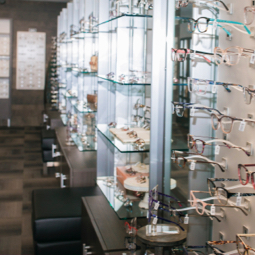Advanced Diagnostics for Advanced Eye Care
Many eye diseases progress without noticeable symptoms but can lead to long-term vision loss and blindness. Routine eye exams are the only way to uncover early signs of disease and protect your eyes. The earlier an eye disease is diagnosed, the easier it can be managed. And with early intervention, vision loss and other complications could be prevented.
At Prairie Vision, our optometrists are trained in advanced optometric care and use leading-edge technology to diagnose and manage common eye diseases and conditions.

Protect Your Eyes with Routine Eye Exams
As the saying goes: “prevention is the best medicine.” Taking preventive measures, like seeing your optometrist for regular eye health checkups, makes protecting your eyes and preserving your eyesight easier if something goes wrong. And our team of eye care professionals at Prairie Vision is here to help you and your family for the long-term. Call us today to schedule an eye exam.

Common Eye Diseases
The 4 leading causes of blindness in Canada are age-related eye diseases. Since an estimated 5.59 million Canadians have an eye disease that can cause sight loss, routine eye exams are a crucial part of preventive health care, protecting your eye health and vision.
At Prairie Vision, we test for common conditions like glaucoma, cataracts, age-related macular degeneration, retinal detachment, and diabetic retinopathy.
Glaucoma
Glaucoma is a group of eye diseases that progressively damage the optic nerve. There are several types of glaucoma, each with its own cause. While many are associated with high intraocular pressure (IOP), there are forms of glaucoma that can occur when IOP is normal.
Glaucoma causes irreversible vision loss and often develops without symptoms, making this disease especially dangerous. As glaucoma advances, you may notice a loss of peripheral vision.
Glaucoma screening involves measuring IOP. Someone with an elevated IOP is considered a glaucoma suspect and may undergo additional testing to confirm a diagnosis. At Prairie Vision, we use the Goldmann applanation tonometer and iCare tonometer to measure IOP and the Humphrey visual field test to evaluate peripheral vision.
Glaucoma can be managed with prescription eye drops that lower IOP, laser treatments to help fluid drain properly, and surgery.
Cataracts
Cataracts are the clouding of the eye’s lens that occurs slowly over time. They generally progress painlessly and are caused by the natural aging process, but they can also be caused by trauma, medications, overexposure to UV radiation, and health conditions like diabetes.
Cataracts are easily diagnosed during a routine eye exam. Mild cataracts can be managed with an updated eyeglass or contact lens prescription, improved lighting, and magnification aids. However, if cataracts worsen and start impacting your quality of life, you may require surgery.
Age-Related Macular Degeneration
Age-related macular degeneration (AMD) is an eye disease that causes the slow breakdown of the macula, the area of the eye responsible for your sharp, central vision. It generally affects those over 55 but can onset at any age.
There are 2 types of AMD:
- Dry AMD is the most common form of the disease and occurs when the macula thins with age. It progresses slowly over several years and has no noticeable symptoms. There’s no treatment to recover vision lost due to dry AMD, but exercise, eating healthy foods, and quitting smoking can slow its progression.
- Wet AMD is less common, but more severe, than dry AMD. It occurs when abnormal blood vessels grow on the back of the eye and damage the macula. Fortunately, treatments are available for wet AMD, and they’re effective at preventing vision loss and preserving what vision remains.
Retinal Detachment
Retinal detachment occurs when the thin, light-sensitive lining of tissue at the back of the eye (the retina) pulls away from its usual position. When this happens, the retinal cells are separated from the nourishing blood vessels that provide them with oxygen, endangering your vision.
A retinal detachment is an eye emergency and requires immediate attention. This condition is often painless but can be accompanied by:
- The sudden appearance of many floaters
- Flashes of light in one or both eyes
- Blurred vision
- Gradually reduced side (peripheral) vision
- A curtain-like shadow over your visual field
Aging, underlying health conditions like diabetes, injuries, or other eye diseases can lead to retinal detachment. If you experience a retinal detachment, you’ll likely need surgery to repair it.
Diabetic Retinopathy
Diabetic retinopathy is a retinal disease that can affect those with diabetes. It occurs when high blood sugar levels damage the blood vessels that supply the retina. At first, diabetic retinopathy can develop without symptoms or mild vision changes, but it can lead to blindness if left untreated.
Learn more about diabetes, diabetic retinopathy, and how we can help at Prairie Vision on our Diabetic Eye Exams page.
Our Location
We serve clients of all ages from Wainwright, Viking, Vermilion, Provost, Lloydminster (Alberta), Macklin (Saskatchewan), and the surrounding areas.
Our Address
- 2802 15th Ave, Unit 2
- Wainwright, AB T9W 0A4
Contact Information
- Phone: 780-842-6123
- Fax: 780-842-3443
- Email: hello@prairievision.com
Hours of Operation
- Monday: 9:30 AM – 5:30 PM
- Tuesday: 8:30 AM – 5:30 PM
- Wednesday: 8:30 AM – 5:30 PM
- Thursday: 8:30 AM – 5:30 PM
- Friday: 8:30 AM – 5:30 PM
- Saturday: Closed
- Sunday: Closed
Closed for all statutory holidays
Our Address
- 5010 50 Street
- Vermilion, AB T9X 1M5
Contact Information
- Phone: 780-853-6501
- Fax: 780-853-6504
- Email: welcome@prairievision.com
Hours of Operation
- Monday: 9:30 AM – 5:00 PM
- Tuesday: 9:00 AM – 5:00 PM
- Wednesday: 9:00 AM – 5:00 PM
- Thursday: 9:00 AM – 5:00 PM
- Friday: 9:00 AM – 5:00 PM
- Saturday: Closed
- Sunday: Closed
Closed for all statutory holidays
Our Brands


























